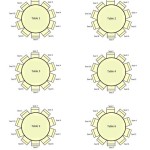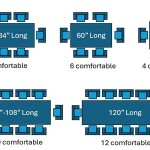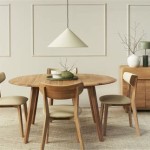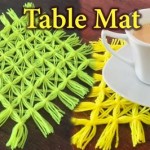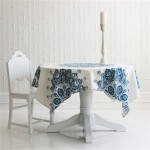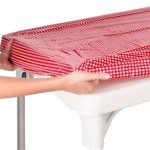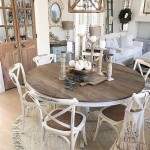How To Make Table Runners For Wedding Reception
Table runners are a versatile and elegant addition to wedding reception decor. They add a layer of texture, color, and visual interest to tablescapes, complementing the overall theme of the event. Creating custom table runners offers a cost-effective way to personalize the wedding reception and ensure a cohesive aesthetic. This article provides a comprehensive guide on how to make table runners for a wedding reception, covering fabric selection, measurement techniques, sewing instructions, and embellishment options.
Key Point 1: Fabric Selection and Preparation
The choice of fabric is fundamental to the overall look and feel of the table runners. The fabric should complement the wedding's color scheme, style, and venue. Consider the following factors when selecting fabric:
Material: Common fabric choices include linen, cotton, satin, burlap, lace, and velvet. Linen offers a classic and sophisticated look, while cotton is a more casual and affordable option. Satin provides a sheen and elegance, and burlap lends a rustic charm. Lace can add delicate details, and velvet offers a luxurious texture. The material should also be durable enough to withstand handling and potential spills.
Color and Pattern: The color of the fabric should coordinate with the wedding's color palette. Solid colors are versatile and easy to match, while patterned fabrics can add visual interest. Floral patterns, geometric designs, or subtle textures can enhance the table setting. Consider using different shades of the same color for a layered look.
Width: The width of the fabric will determine the width of the table runner. Standard table runner widths range from 12 to 16 inches, but this can be adjusted depending on the size and shape of the tables and the desired aesthetic. Wider runners can create a more dramatic effect, while narrower runners are more understated.
Quantity: Calculate the amount of fabric needed based on the number of tables, the length of each table, and the desired overhang. It is always advisable to purchase extra fabric to account for errors or adjustments.
Once the fabric is selected, proper preparation is crucial. This involves the following steps:
Pre-washing: Wash and dry the fabric according to the manufacturer's instructions before cutting. This will help prevent shrinkage and color bleeding after the table runners are made. Ironing the fabric after washing will provide a smooth surface for cutting and sewing.
Cutting: Measure and cut the fabric into the desired length and width. Use a rotary cutter, cutting mat, and ruler for precise cuts. Ensure that the fabric is straight and even to avoid crooked table runners. If using patterned fabric, pay attention to the pattern placement to ensure a consistent look across all the runners.
Seam Allowance: Add a seam allowance of at least 1/2 inch on all sides of the fabric. This will allow for a clean and finished edge. A wider seam allowance may be necessary for thicker fabrics or more elaborate edge finishes.
Key Point 2: Sewing Techniques and Edge Finishes
The sewing process involves creating a clean and durable edge finish for the table runners. There are several sewing techniques that can be used, depending on the desired look and the fabric type. The following techniques are amongst some of the most popular:
Straight Stitching: This is the most basic sewing technique and involves stitching a straight line along the edges of the fabric. Use a standard sewing machine with a universal needle and appropriate thread for the fabric type. Sew along the edge of the fabric, using the seam allowance as a guide. Backstitch at the beginning and end of each seam to secure the stitches.
Hemming: Hemming involves folding the raw edges of the fabric over and stitching them in place. This creates a clean and finished edge that prevents fraying. There are several hemming techniques, including:
Double-Fold Hem: Fold the raw edge of the fabric over by 1/4 inch and press. Then, fold it over again by 1/2 inch and press. Stitch along the folded edge to secure the hem. This is a durable and professional-looking hem that is suitable for most fabrics.
Narrow Hem: Fold the raw edge of the fabric over by 1/8 inch and press. Then, fold it over again by 1/4 inch and press. Stitch along the folded edge to secure the hem. This is a delicate hem that is suitable for lightweight fabrics like lace or chiffon.
Blind Hem: This technique creates an invisible hem on the right side of the fabric. Use a blind hem foot on the sewing machine and follow the manufacturer's instructions. This is a sophisticated hem that is suitable for formal events.
Serging: Serging involves using a serger machine to overlock the raw edges of the fabric. This creates a clean and durable edge that prevents fraying. Serging is a quick and efficient way to finish the edges of table runners, especially for fabrics that are prone to fraying.
Bias Binding: Bias binding is a strip of fabric that is cut on the bias (at a 45-degree angle to the grain) and sewn along the edges of the fabric. This creates a decorative and durable edge finish. Bias binding is available in a variety of colors and patterns, allowing for customization.
Mitered Corners: Mitered corners create a clean and professional finish at the corners of the table runners. This involves folding and pressing the fabric diagonally at the corners to create a sharp and even corner. Mitered corners are particularly important for table runners with wide hems or bias binding.
After sewing the edge finish, press the seams to create a flat and smooth surface. This will enhance the overall look of the table runners.
Key Point 3: Embellishments and Customization
Embellishments can add a personal touch to the table runners and enhance their visual appeal. There are a variety of embellishment options to choose from, depending on the wedding's style and theme. The following are some common embellishment techniques:
Lace Trim: Adding lace trim along the edges of the table runners can create a delicate and romantic look. Lace trim is available in a variety of styles, widths, and colors. Sew the lace trim along the edges of the fabric, using a straight stitch or a decorative stitch.
Ribbon: Ribbon can be used to create decorative borders or accents on the table runners. Choose ribbon that complements the fabric color and texture. Sew the ribbon along the edges of the fabric, or create ribbon bows or rosettes to add dimension.
Beads and Sequins: Beads and sequins can add sparkle and glamour to the table runners. Sew beads and sequins onto the fabric by hand, creating intricate patterns or accents. Use a variety of bead sizes and colors to add visual interest.
Embroidery: Embroidery can be used to create personalized designs or monograms on the table runners. Use an embroidery machine or hand embroidery techniques to create custom designs. Embroidery can add a unique and sentimental touch to the table runners.
Appliques: Appliques are decorative fabric pieces that are sewn onto the fabric. Appliques can be used to create floral designs, geometric patterns, or custom designs. Choose appliques that complement the fabric color and texture. Fuse the appliques onto the fabric using fusible adhesive, and then sew around the edges to secure them.
Stenciling: Stenciling involves using stencils and fabric paint to create designs on the fabric. This is a simple and affordable way to add custom designs to the table runners. Choose stencils that complement the wedding's theme. Secure the stencil onto the fabric using painter's tape, and then apply fabric paint using a stencil brush or sponge. Allow the paint to dry completely before removing the stencil.
Fabric Dyeing: Dyeing the fabric before or after sewing can add custom colors or patterns to the table runners. Use fabric dyes that are compatible with the fabric type. Follow the manufacturer's instructions for dyeing the fabric. Dyeing can create unique ombre effects or tie-dye patterns.
When adding embellishments, consider the overall balance and symmetry of the table runners. Avoid overcrowding the fabric with too many embellishments. A minimalist approach can often be more effective in creating a sophisticated and elegant look.
Creating table runners for a wedding reception can be a rewarding and cost-effective way to personalize the event decor. By carefully selecting fabrics, mastering sewing techniques, and adding custom embellishments, it is possible to craft table runners that will enhance the beauty and elegance of the wedding reception.
:max_bytes(150000):strip_icc()/PHOTOBYIVASHSTUDIO-ffbd92093844439fa76f08336fc063fe.jpg?strip=all)
25 Eye Catching Table Runner Ideas For Your Wedding Reception

18 Table Runners That Will Transform Your Wedding

20 Gorgeous Wedding Table Runner Ideas Wedboard

Rustic Farm Table Runner Ideas Arranjo De Mesa Casamento Rustica Rústico

20 Gorgeous Wedding Table Runner Ideas Wedboard

Now You Can Host The Most Beautiful Wedding With Custom Table Runners Best Of Signs Blogs For Banners Printing Tips Services

How To Have A Raging Wedding That Is Classy Table Runners Linens Round Tables

20 Gorgeous Wedding Table Runner Ideas Wedboard

Wedding Table Runners Tablecloths 10 Ideas For Your Reception Tables

20 Gorgeous Wedding Table Runner Ideas Wedboard
Related Posts

